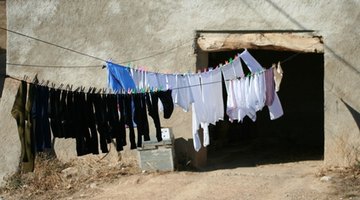Chemical Reactions With Bleach
Common household bleach is an aqueous solution of 5.25 percent sodium hypochlorite used for stain removal and sanitation in laundry and cleaning products. Sodium hypochlorite is an oxidizer, and reacts with reducing agents, organic compounds, cleaning products and acids.

It can form hazardous products during reactions with certain cleaning agents and acids.
Cleaning Products
Bleach is highly reactive and can form toxic gases when combined with other common household cleaners. Bleach and ammonia react to from chloramines, which are nitrogen compounds with one or more attached chlorine atoms. Chloramines evolve as a toxic gas from this reaction because they are less soluble than ammonia. Bleach also reacts with cleaners that contain phosphoric acid or sulfuric acid, such as toilet bowl cleaners and drain cleaners. These reactions release heat and produce highly corrosive compounds.
Acetic Acid
Acetic acid is an effective reducing agent in oxidation-reduction (redox) reactions with bleach. Redox reactions occur when an oxidizing agent, such as bleach, becomes reduced (i.e., its ions lose electrons). Reducing agents, such as acetic acid, become oxidized: their ions gain electrons. The reaction of bleach and acetic acid releases chlorine gas, which can irritate the eyes, nose and throat and cause breathing problems and vomiting. When combined with water, chlorine gas forms hydrochloric and hypochlorous acids.
Organic Compounds
Bleach releases hypochlorite, which oxidizes the organic compounds in fabric dyes and stains. During some of these reactions, the chemical bonds of the organic compounds break and the smaller, water-soluble molecules rinse away, resulting in the removal of stains, and the color, from dyed fabrics. Organic fibers such as wool and hair are acidic and can be neutralized by bleach. In this type of reaction, the fibers disintegrate as the bleach neutralizes the acids. Water and salts are the products of this reaction.
References
Writer Bio
Alissa Pond Mentzer worked in biotech research and educational publishing before becoming a freelance writer in 2005. She has contributed to textbooks for The Mcgraw-Hill Companies and National Geographic School Division and writes science articles for various websites. Mentzer earned a Bachelor of Arts from Rutgers University in anthropology and biological sciences.
Photo Credits
- TENDEDERO image by diego castillo from Fotolia.com
- TENDEDERO image by diego castillo from Fotolia.com
More Articles



